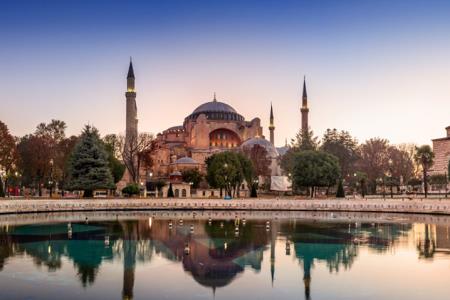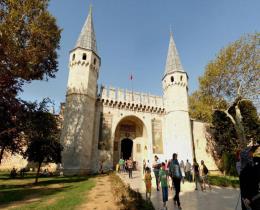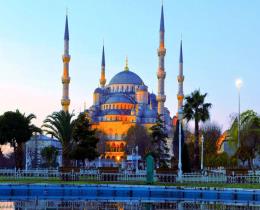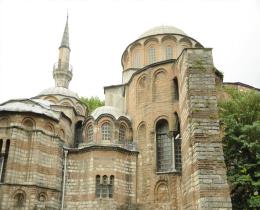|
 Topkapi is the largest and oldest palace in the world to survive to our day. In 1924 it was turned into a museum at Atatiirk's request. Situated on the acropolis, the site of the first settlement in Istanbul, it commands an impressive view of the Golden Horn, the Bosphorus and the Sea of Marmara. The palace is a complex surrounded by 5 km of walls and occupies an area of 700,000 sq. m at the tip of the historical peninsula. Topkapi is the largest and oldest palace in the world to survive to our day. In 1924 it was turned into a museum at Atatiirk's request. Situated on the acropolis, the site of the first settlement in Istanbul, it commands an impressive view of the Golden Horn, the Bosphorus and the Sea of Marmara. The palace is a complex surrounded by 5 km of walls and occupies an area of 700,000 sq. m at the tip of the historical peninsula.
Following the conquest of the city in 1453, the young Sultan Mehmet moved the capital of the empire to Istanbul, His first palace was located in the middle of the town. The second palace, which he built in the 1470's, was initially called the New Palace, but in recent times it came to be known as the Topkapi Palace. Topkapı is a classical example of Turkish palace architecture. It consists of tree- shaded courtyards, each serving a different purpose and opening onto one another with monumental gates. The courtyards are surrounded by functional buildings. From the time of its construction, the palace developed constantly with alterations and additions made by each sultan.
When the sultans moved to the ostentatious Dolmabahçe Palace in 1853, Topkapı lost its importance as the official royal residence and was left to deteriorate. It finally regained its former unpretentious beauty after fifty years of continuous restoration in the Republican era. Most of the objects exhibited in the palace today are unique masterpieces.
When it was used as a palace, it served more functions than one usually associates with royal residences. Although it was the residence of the Sultan, the sole ruler of the empire, it was at the same time the center of the administrative affairs, the place where the council of ministers met, and the treasury, mint, and state archives were located there. The highest educational institution of the empire, the university of the sultan and the state was also here. Therefore it was the heart, the brain, the very center of the Ottoman Empire. Much later, the harem (private quarters) of the sultans was moved here too.
Of the sixteen empires founded by the Turks, the Ottoman Empire was the longest lasting and the largest. It lasted for 622 years ruling over the Asian, European and African lands surrounding the Mediterranean and the Black Sea.
Peoples of different races and religions were united under its rule. The only other empire in history that governed such vast lands for such a long period was the Roman Empire.
Thirty-six sultans reigned during this period, and starting from early 16th century, they also became the religious leaders of the Islamic world as caliphs.
Capable civil servants, after completing their education in the school in the private courtyard of the sultan, served faithfully and successfully in the administration and organization of the empire. Most of the viziers and grand viziers were graduates of this school. Life started at dawn in the palace and it was subject to strict rules and ceremonies. Everybody had to abide by the centuries-old customs and traditions, and these were observed rigorously even when the empire fell into a period of decline. The etiquette of this palace always influenced the rules of protocol in the Western world.
The seaside mansions and pavilions of Topkapi Palace were demolished at the end of the last century.
The different tiles, woodwork and architectural styles displayed in Topkapı Palace reflects the development of Turkish art and the harmonious existence of differing styles over the centuries.
VISITING THE PALACE THE FIRST COURTYARD
 The first courtyard is entered through the so-called Imperial Gate. The monumental fountain seen outside the gate is a beautiful example of 18th century Turkish art. In this courtyard there are the palace bakery, the mint, the quarters of the palace guards, and the firewood depots. The vegetable gardens used to occupy the terraces below. The first building in the palace complex, the Tiled Pavilion, and the Archeological Museum are in this courtyard, too. To the left of the entrance is the Hagia Eirene Museum, a 6th century Byzantine church. The first courtyard is entered through the so-called Imperial Gate. The monumental fountain seen outside the gate is a beautiful example of 18th century Turkish art. In this courtyard there are the palace bakery, the mint, the quarters of the palace guards, and the firewood depots. The vegetable gardens used to occupy the terraces below. The first building in the palace complex, the Tiled Pavilion, and the Archeological Museum are in this courtyard, too. To the left of the entrance is the Hagia Eirene Museum, a 6th century Byzantine church.
THE SECOND COURTYARD
The main entrance to the Palace Museum is the second gate, known as the Gate of Salutation. The second courtyard was the administrative center of the state and the government. Only the sultans could enter this yard on horseback. Citizens with official business were allowed here, as well as the representatives of the Janissary corps on special paydays.
br> The reception of foreign emissaries and state ceremonies took place in this courtyard. It is known that absolute silence prevailed in such ceremonies, sometimes attended by up to ten thousand people. When the sultan was present in the event, the imperial throne was placed in front of the gate at the other end of the courtyard, and as a demonstration of respect; that present would stand with their hands clasped in front. The only tower in the palace is located here too. It was called "the Tower of Justice" because it was the venue of the state court of justice. The entire city and the port could be kept under observation from this tower, the only entrance of which was from the harem section.
THE HAREM
 The harem was the private zone of the palace, where the mother and siblings of the sultan, the other members of the family, and the concubines and eunuchs who served this large family lived. Until the mid-16th century the harem was housed in the Old Palace in another part of the town. The harem of Topkapi Palace consists of long narrow hallways and about 400 rooms scattered around small courtyards. It was altered and enlarged over the years. The harem was the private zone of the palace, where the mother and siblings of the sultan, the other members of the family, and the concubines and eunuchs who served this large family lived. Until the mid-16th century the harem was housed in the Old Palace in another part of the town. The harem of Topkapi Palace consists of long narrow hallways and about 400 rooms scattered around small courtyards. It was altered and enlarged over the years.
The harem was strictly closed to outsiders, and it became the subject of many stories over the centuries. The concubines serving the sultan and his family were chosen from among the most beautiful and healthy girls of different races or they were presented to the court as gifts.
These girls came to the harem at a very early age and were brought up under strict discipline. After they became thoroughly acquainted with the customs of the palace, they were separated into different groups. Those who could attract the attention of the sultan had the chance of becoming his wife.
There was no such title in the empire as "empress". The sultan's mother was the sole ruler in the harem. Amid the entire splendor and wealth, rivalry, hatred and intrigues to get closer to the sultan were part of the daily life.
When a new sultan ascended to the throne, the harem of the former sultan was moved to another palace. The ladies of the harem and the chief eunuchs emerged as a political power influencing state administration if the reigning sultan was weak and ineffective. Still, life in the harem with all its intrigues, good and bad parts was superior to the life style of women of that period elsewhere.
Only a section of the harem is open to the public. It is up to the imagination of the visitor to recreate the colorful and lively old days in these dim hallways and empty rooms.
The tour of the harem starts with the 40-room section allocated to the mother of the sultan. The next sections are the large Turkish bath and the spacious, domed hall reserved for the sultans.
There are fireplaces and fountains in all available places. The large hall with a pool filled by interesting fountains is decorated with exquisite 16th century tiles. It dates to the reign of Murat III. From the end of this hall, one enters the small library and the "fruit room" which is embellished with paintings of fruits and flowers.
The two 16th century rooms seen at the end of the harem tour have beautiful stained glass windows complementing the rich wall decorations. These rooms were allocated to the crown prince.
|
|
THE WEAPON COLLECTION AND THE COUNCIL HALL
The large structure next to the "council of state" building with broad eaves was the state treasury. This eight-domed building today houses rich collection of old weapons in a modern exhibition.
Besides the armor and weapons used by the sultans, those used by the members of the palace and the army is displayed here along with weapons conquered from other countries.
The Tower of Justice rises beside the "council of state" section. The council was composed of the viziers and secretaries, and the grand vizier chaired the meetings.
The sultans did not participate in the meetings, but could listen to the deliberations from a high window in one of the walls. This window opened to the harem section and a curtain masked it. The feasts given in honor of visiting foreign missions took place in this hall.
THE KITCHENS AND THE PORCELAIN COLLECTION
On the right side of the second courtyard are the palace kitchens with twenty chimneys. Of the 12,000 pieces of Chinese and Japanese porcelain in the palace collection, about 2,500 are on display in this section.
When these b uildings were used as kitchens, over one thousand cooks and their assistants prepared and served meals for the various sections of the palace.
Selected pieces of the largest such collection in the world are displayed in a chronological order. Sections of the kitchens have been kept as they were when in use, while another part is allocated to porcelain and glassware produced in Istanbul. Another section houses the collection of silverware and European porcelain. The unique Chinese celadons are in the room to the right. The exhibition of blue and white, mono- and polychrome porcelain objects ends with the Japanese porcelain collection. In the special kitchen where sweets used to be made, everyday kitchen utensils, coffee sets and gold-plated . copper wares are displayed.
THE THIRD COURTYARD
The third courtyard was the private domain of the sultan and it was entered —only by special permission- through the Gate of Felicity, guarded by the White Eunuchs. The imperial university, the throne room, the treasury of the sultan and the quarters housing the sacred relics were located in this section. The sultans received foreign ambassadors and high government officials in the throne room, which is directly opposite the entrance. For security reasons those serving in the throne room were selected from among deaf and mute persons.
The military officers who served the sultan in various capacities were at the same time the managers of the imperial school.
The library of Ahmet III in the center of the courtyard is an 18th century building that is a typical example of the harmonious blend of the baroque and Turkish architectural styles.
THE COSTUMES
Unique collections of the sultans' wardrobes are displayed in the section to the right of the courtyard. There are altogether 2,500 of these handmade costumes that were made of fabric woven on the palace looms and preserved carefully in special chests since the 15th century. Besides these garments embroidered with silk, gold and silver thread, there are also silk carpets and prayer rugs, masterpieces of Turkish art, used by the sultans.
THE TREASURY

The treasury section of the Topkapi Palace Museum is the richest collection of its kind in the world. All the pieces exhibited in the four rooms are authentic originals.
Masterpieces of the Turkish art of jewelry from different centuries and exquisite creations from the Far East, India and Europe entrance visitors. In each room there is an imperial throne from a different era. Ceremonial costumes, weapons, water pipes, Turkish coffee cups and other wares, all of them embellished with gold and precious stones are the most important items in the first room.
The second hall is known as the Emerald Room. It contains dazzling display of aigrettes and pendants decorated with emeralds and other jewels. Uncut emeralds, some weighing several kilograms each, and the famous Topkapi Dagger (the symbol of the museum) embellished with three large emeralds are also on display here.
The third room contains enameled objects, medals and decorations of state presented to the sultans by foreign monarchs, the twin solid gold candelabras each weighing 48 kilograms, and the most famous throne in the palace, the golden throne, which the sultans used during coronations and religious holidays. The 86-carat Spoon Maker's (or Pigot) Diamond, one of the most famous diamonds in the world, is also to be found here. The balcony connecting the third and the fourth rooms offers a breathtaking view of the entrance to the Bosphorus and the Asian coast. In the fourth room, a magnificent throne of Indian-Persian origin is on display. There are also many other objects encrusted with precious stones of different sizes to captivate visitors.
THE CLOCK COLLECTION
The richest collection of clocks in the world is exhibited in the room next to the Sacred Relics Section. To the right of the entrance there are clocks made by Turkish masters. These priceless wall and table clocks and watches are from the 16th-19th centuries. Clocks of a huge variety of makes were presented to the palace as gifts.
The largest clock in the room is one of English origin. It is 3.5 m high and 1 m wide, and contains an organ. Some pieces of special interest are the watches with the portraits of Abdulmecid and Abdulaziz, and a birdcage hanging from the dome, the underside of which is an enameled clock.
THE SACRED RELICS
 The sacred relics of Islam were brought to the palace after the conquest of Egypt in the 16th century and have been preserved here since that time. This hall was used as the throne room before it was allocated to the sacred relics. The walls of the domed rooms are covered with tiles. Important pieces of the collection are the swords and bow of Mohammed and his mantle (cloak), which is kept in a priceless box. The seal of the Prophet, hairs from his beard, his footprint and a letter are other exhibits in the showcases in these rooms. Also on display are one of the first manuscripts of The Koran, the keys of the Ka'aba in Mecca, and the swords of prominent religious personalities. The sacred relics of Islam were brought to the palace after the conquest of Egypt in the 16th century and have been preserved here since that time. This hall was used as the throne room before it was allocated to the sacred relics. The walls of the domed rooms are covered with tiles. Important pieces of the collection are the swords and bow of Mohammed and his mantle (cloak), which is kept in a priceless box. The seal of the Prophet, hairs from his beard, his footprint and a letter are other exhibits in the showcases in these rooms. Also on display are one of the first manuscripts of The Koran, the keys of the Ka'aba in Mecca, and the swords of prominent religious personalities.
PORTRAITS OF THE SULTANS
This gallery is located in the building with a colonnade, which stands between the Sacred Relics Section and the Treasury and also houses the museum offices. In the large hall, temporary exhibitions are organized from time to time.
The Palace Museum has a rich collection of manuscripts, books, miniatures and writing tools. Some of these rare items are displayed in this section. Oil portraits of the sultans adorn the walls of the balcony-shaped galleries of the hall.
THE FOURTH COURTYARD
A passageway leads from the third to the fourth courtyard where there are a number of pavilions set amidst gardens. The only wooden pavilion in the complex, the Revan and exquisitely decorated Baghdad Pavillions from the 17th century, and the last addition to the palace, the Mecidiye Köşkü, are some of the buildings here. On the ground floor of the last building there is a restaurant for visitors. The terrace in front of Baghdad Pavillion is the best place to Interior of Baghdad Pavilion (17th cent.). get an overall view of the Golden Horn, the Galata district, and the wonderful skyline of old Istanbul with its domes and minarets. The gardens of the palace sloping toward the sea have now been turned into a public park.
|

 English
English Español
Español Deutsch
Deutsch عربي
عربي  Русский
Русский

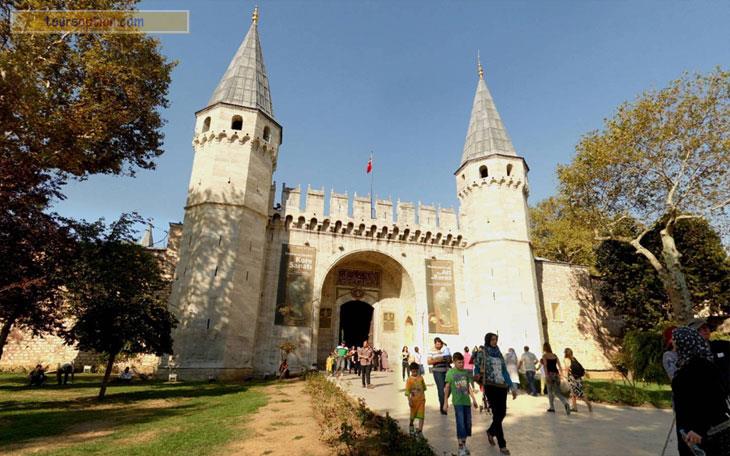
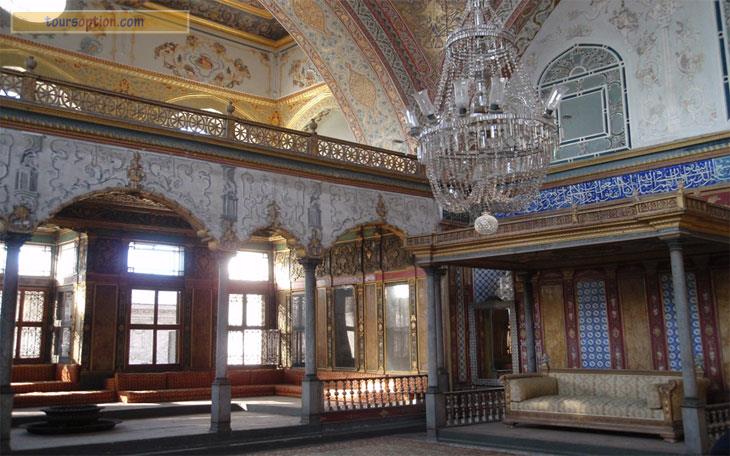
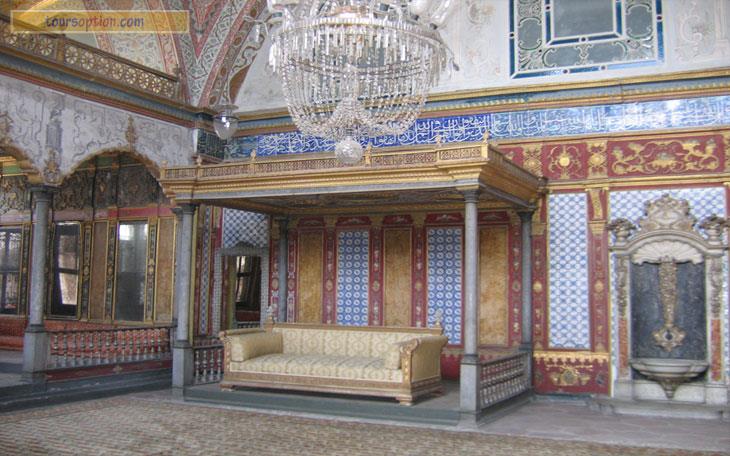
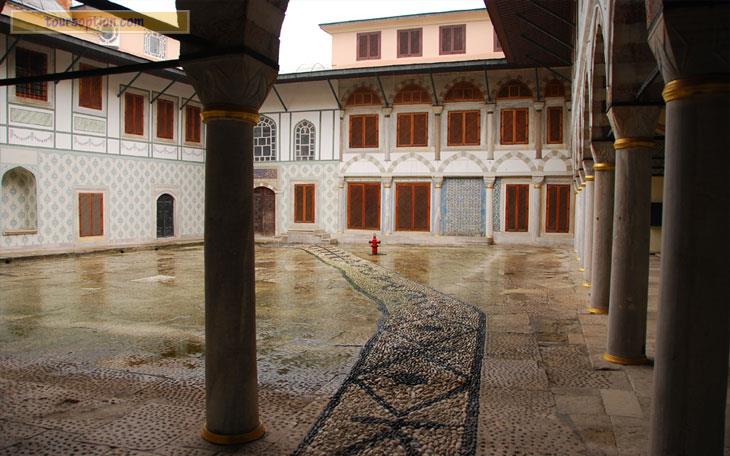
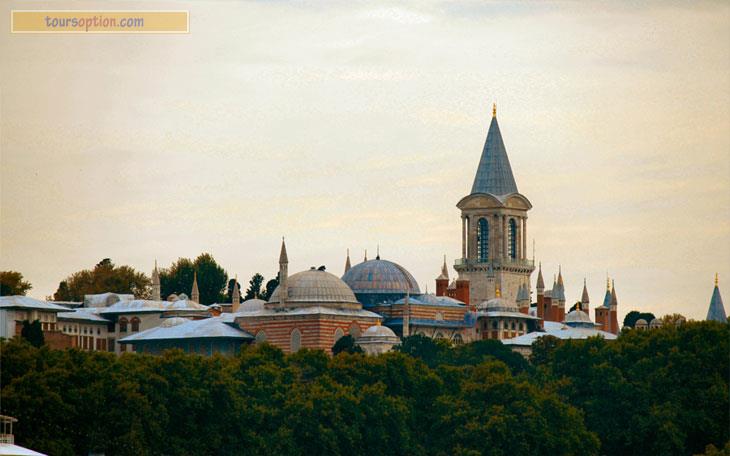

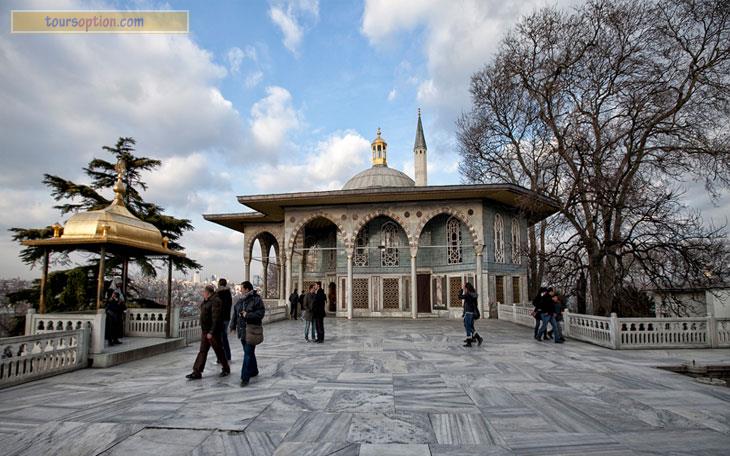
 Topkapi is the largest and oldest palace in the world to survive to our day. In 1924 it was turned into a museum at Atatiirk's request. Situated on the acropolis, the site of the first settlement in Istanbul, it commands an impressive view of the Golden Horn, the Bosphorus and the Sea of Marmara. The palace is a complex surrounded by 5 km of walls and occupies an area of 700,000 sq. m at the tip of the historical peninsula.
Topkapi is the largest and oldest palace in the world to survive to our day. In 1924 it was turned into a museum at Atatiirk's request. Situated on the acropolis, the site of the first settlement in Istanbul, it commands an impressive view of the Golden Horn, the Bosphorus and the Sea of Marmara. The palace is a complex surrounded by 5 km of walls and occupies an area of 700,000 sq. m at the tip of the historical peninsula.  The first courtyard is entered through the so-called Imperial Gate. The monumental fountain seen outside the gate is a beautiful example of 18th century Turkish art. In this courtyard there are the palace bakery, the mint, the quarters of the palace guards, and the firewood depots. The vegetable gardens used to occupy the terraces below. The first building in the palace complex, the Tiled Pavilion, and the Archeological Museum are in this courtyard, too. To the left of the entrance is the Hagia Eirene Museum, a 6th century Byzantine church.
The first courtyard is entered through the so-called Imperial Gate. The monumental fountain seen outside the gate is a beautiful example of 18th century Turkish art. In this courtyard there are the palace bakery, the mint, the quarters of the palace guards, and the firewood depots. The vegetable gardens used to occupy the terraces below. The first building in the palace complex, the Tiled Pavilion, and the Archeological Museum are in this courtyard, too. To the left of the entrance is the Hagia Eirene Museum, a 6th century Byzantine church. The harem was the private zone of the palace, where the mother and siblings of the sultan, the other members of the family, and the concubines and eunuchs who served this large family lived. Until the mid-16th century the harem was housed in the Old Palace in another part of the town. The harem of Topkapi Palace consists of long narrow hallways and about 400 rooms scattered around small courtyards. It was altered and enlarged over the years.
The harem was the private zone of the palace, where the mother and siblings of the sultan, the other members of the family, and the concubines and eunuchs who served this large family lived. Until the mid-16th century the harem was housed in the Old Palace in another part of the town. The harem of Topkapi Palace consists of long narrow hallways and about 400 rooms scattered around small courtyards. It was altered and enlarged over the years. 
 The sacred relics of Islam were brought to the palace after the conquest of Egypt in the 16th century and have been preserved here since that time. This hall was used as the throne room before it was allocated to the sacred relics. The walls of the domed rooms are covered with tiles. Important pieces of the collection are the swords and bow of Mohammed and his mantle (cloak), which is kept in a priceless box. The seal of the Prophet, hairs from his beard, his footprint and a letter are other exhibits in the showcases in these rooms. Also on display are one of the first manuscripts of The Koran, the keys of the Ka'aba in Mecca, and the swords of prominent religious personalities.
The sacred relics of Islam were brought to the palace after the conquest of Egypt in the 16th century and have been preserved here since that time. This hall was used as the throne room before it was allocated to the sacred relics. The walls of the domed rooms are covered with tiles. Important pieces of the collection are the swords and bow of Mohammed and his mantle (cloak), which is kept in a priceless box. The seal of the Prophet, hairs from his beard, his footprint and a letter are other exhibits in the showcases in these rooms. Also on display are one of the first manuscripts of The Koran, the keys of the Ka'aba in Mecca, and the swords of prominent religious personalities.

